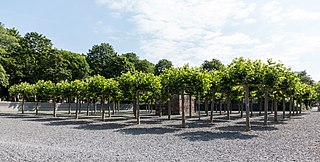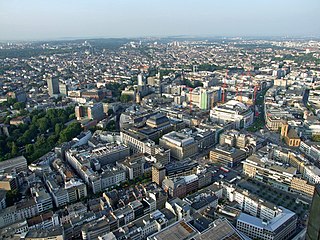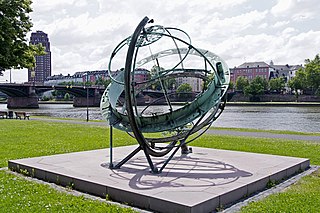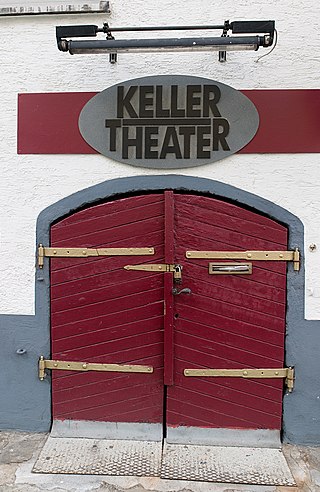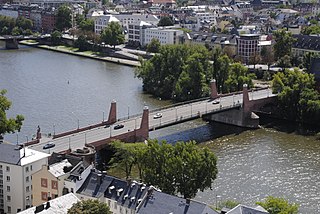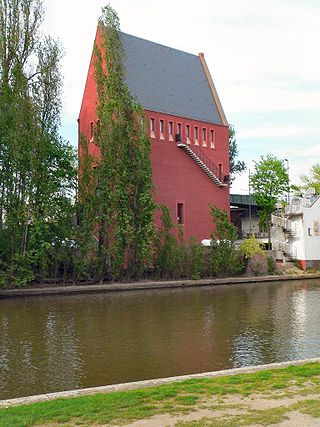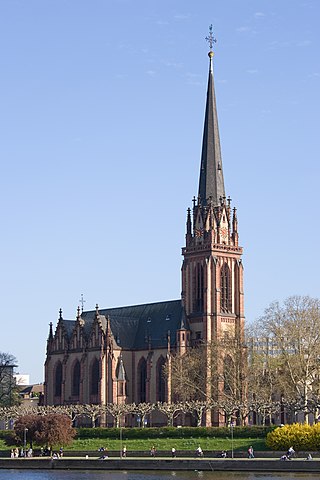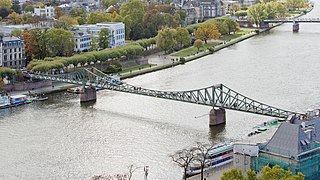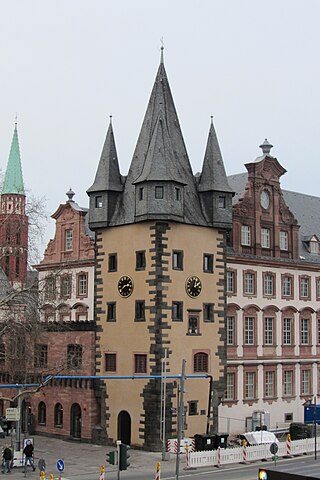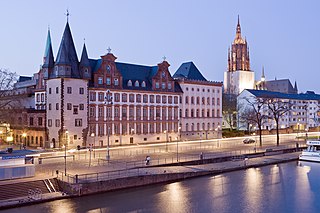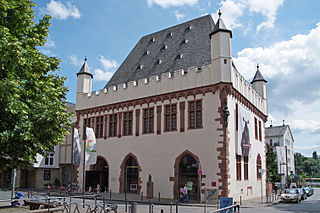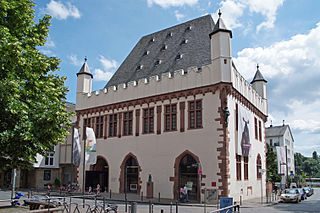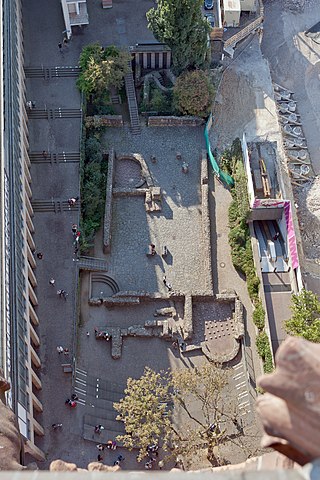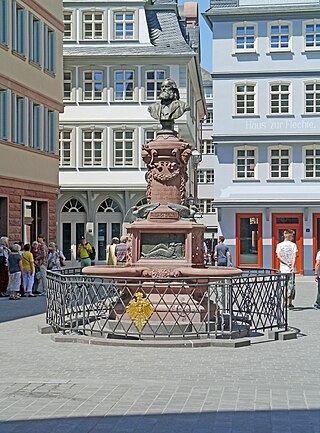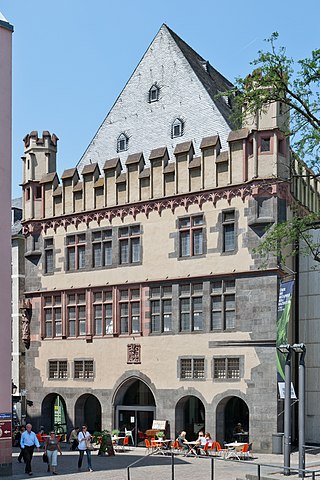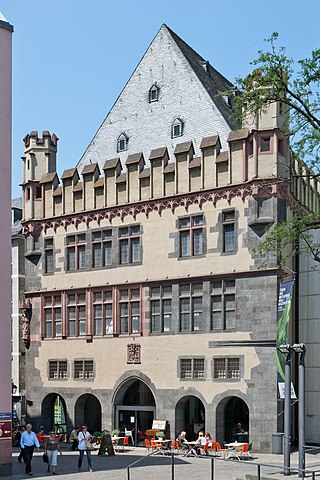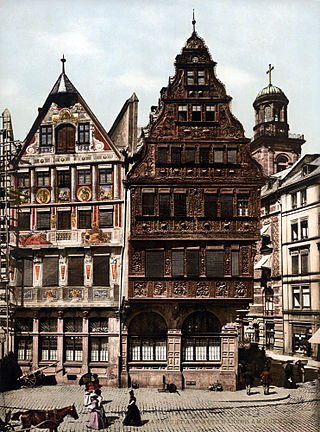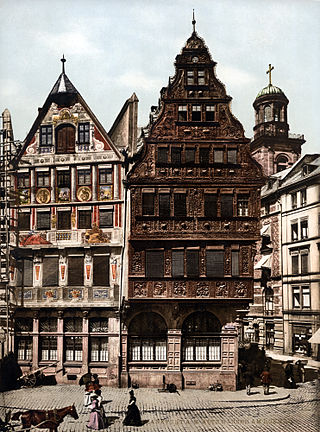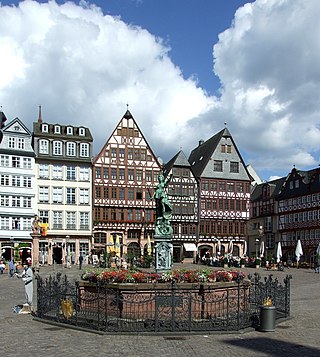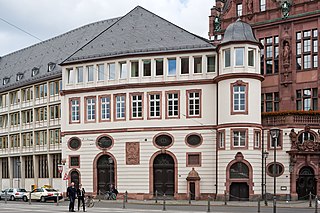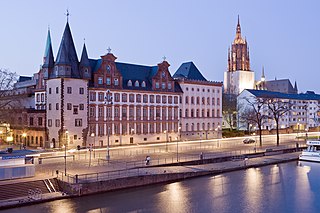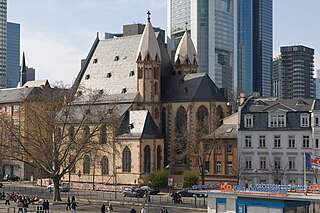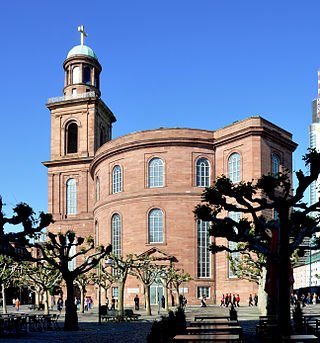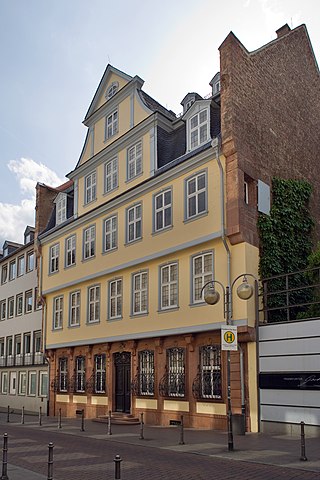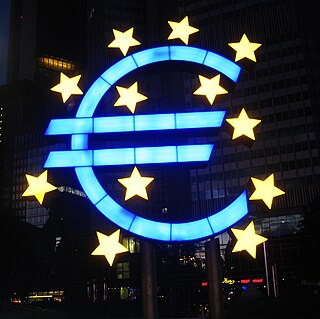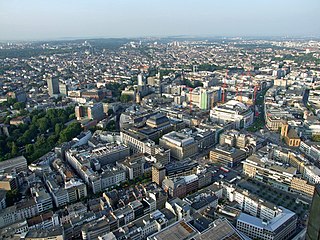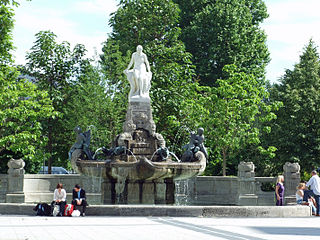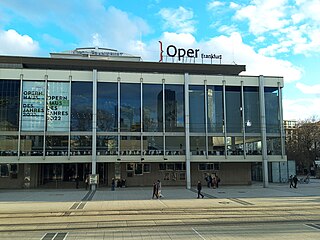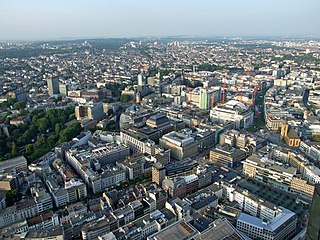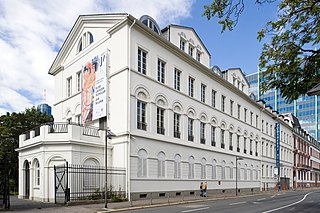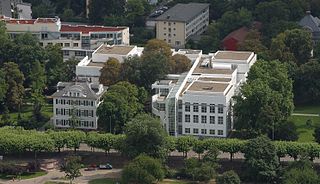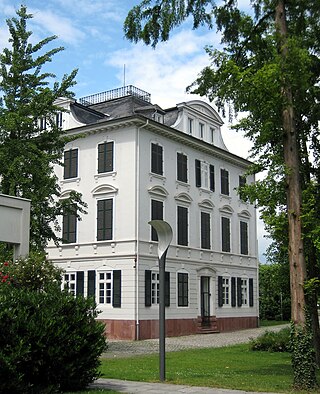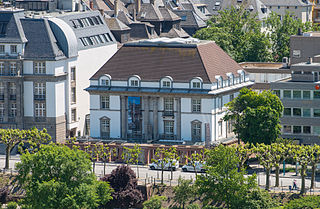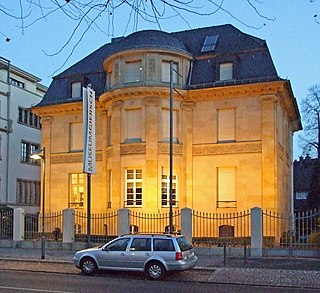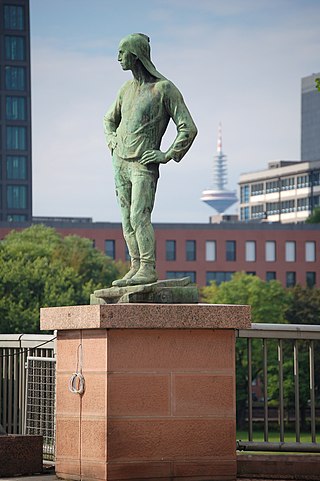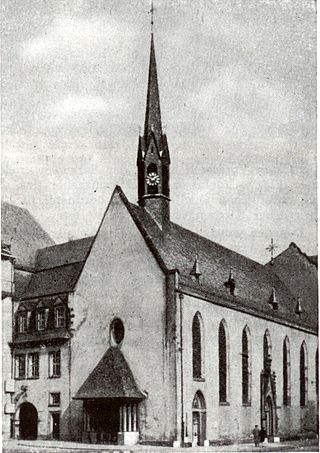Self-guided Sightseeing Tour #2 in Frankfurt, Germany
Legend
Guided Free Walking Tours
Book free guided walking tours in Frankfurt.
Guided Sightseeing Tours
Book guided sightseeing tours and activities in Frankfurt.
Tour Facts
9.4 km
224 m
Experience Frankfurt in Germany in a whole new way with our free self-guided sightseeing tour. This site not only offers you practical information and insider tips, but also a rich variety of activities and sights you shouldn't miss. Whether you love art and culture, want to explore historical sites or simply want to experience the vibrant atmosphere of a lively city - you'll find everything you need for your personal adventure here.
Activities in FrankfurtIndividual Sights in FrankfurtSight 1: Heiliggeistkirche
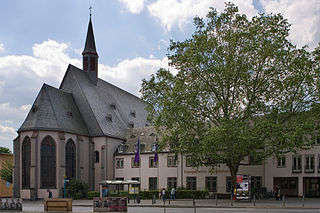
The Church of the Holy Spirit is a Protestant church in Frankfurt am Main, Germany. It was inaugurated on the second Sunday of Advent in 1961 as a reconstruction of the late Gothic hall church of the Dominican monastery, which had been destroyed in an air raid in 1944. The Dominican monastery is the seat of the Protestant city deanery of Frankfurt am Main and the Protestant Regional Association, an association of all Protestant congregations in Frankfurt.
Wikipedia: Heiliggeistkirche (Frankfurt am Main) (DE), Heritage Website
Sight 2: Gedenkstätte Neuer Börneplatz
The Neuer Börneplatz Memorial Site, also called Börneplatz Memorial Site, in Frankfurt am Main commemorates the Jewish community of Frankfurt that was destroyed in the Holocaust. It was opened to the public on 16 June 1996.
Sight 3: Obermainanlage
The Frankfurt ramparts form a ring-shaped green area around the city centre of Frankfurt am Main. They were built at the beginning of the 19th century on the site of Frankfurt's city fortifications, which were razed between 1804 and 1812. The Frankfurt Anlagenring runs around the ramparts.
Sight 4: Aequatorial-Sonnenuhr
The Frankfurt Equatorial Sundial, sometimes also referred to as a copper clock, is a ring-shaped equatorial sundial designed as a world clock. Since 2004, it has stood in Frankfurt's inner city district on a green area west of the Ignatz Bubis Bridge on the banks of the Main below the Schöne Aussicht. When it was inaugurated in 1951, the Frankfurt Equatorial Sundial was considered the largest sundial of its kind in the world.
Sight 5: Kellertheater Frankfurt
The Kellertheater Frankfurt is an independent, completely volunteer-run theater in Frankfurt am Main. It has been located at Mainstraße 2 since 1980. It is run by the Junge Bühne Frankfurt e. V. and has been entered in the register of associations since 1975. The Kellertheater is a member of the Frankfurter Theaterallianz e. V.
Sight 6: Charlemagne statue
Alte Brücke is a bridge in Frankfurt, Hesse, Germany. It is the oldest bridge over the lower course of the river Main, and until 1886 was the only stone bridge crossing the river. From the Middle Ages until the year 1914, it connected the "Fahrgasse" in Frankfurt Altstadt with the "Brückenstraße" in Sachsenhausen. Since its first mention in official documents in 1222, the development of Frankfurt has been strongly influenced by the bridge. Over the centuries, Alte Brücke has been destroyed and reconstructed at least 18 times. With its 13 brick-built circular arches, the Sachsenhausen Bridge was one of the most prominent buildings of the city, but failing to meet the increasing demands of the modern road and ship traffic, it was demolished in 1914.
Sight 7: Portikus
Portikus is an exhibition institution for contemporary art in Frankfurt am Main. It was opened in 1987 in a container room behind the classicist columned frontispiece of the Old City Library and has been located on the Main Island at the Old Bridge since 2006. In addition to current works by internationally renowned artists, positions by young artists will also be shown. Since its founding in 1987, Portikus has been an integral part of the Städelschule and contributes to the enrichment of the curriculum and the international reputation of the school. From October 2014 to the end of 2017, Fabian Schöneich was curator of Portikus, followed by Christina Lehnert, who most recently headed the Braunschweiger Kunstverein. On July 1, 2022, the curatorial duo Liberty Adrien and Carina Bukuts took over the management.
Sight 8: Dreikönigskirche
Join Free Tour*The Dreikönigskirche is a Lutheran Protestant church and parish in Frankfurt, the city's largest Protestant parish. It is located on the south bank of the Main in Sachsenhausen, opposite the Frankfurt Cathedral. The present church building, replacing an older church, was erected from 1875 to 1880 on designs by Franz Josef Denzinger in Gothic revival style. It features stained glass windows by Charles Crodel, installed in 1956, and an organ by Karl Schuke from Berlin completed in 1961.
Sight 9: Ulrichstein marking
The Ulrichstein was part of Frankfurt's city fortifications. It was first mentioned in a document in 1391 in the directory of gates and towers, so it was already in the possession of the city at that time as part of the Sachsenhausen city wall.
Sight 10: Eiserner Steg
Join Free Tour*The Eiserner Steg is a footbridge spanning the river Main in the city of Frankfurt, Germany, which connects the centre of Frankfurt with the district of Sachsenhausen.
Sight 11: Rententurm
The Rententurm is a late Gothic gate tower of the former city fortifications of Frankfurt am Main and part of the Saalhof. The tower secured the gate, which, as Frankfurt's most important city gate on the Main side, connected the centre of the historic city centre, the Römerberg, with the harbour on the banks of the Main outside the city wall. Opposite the Rententurm on the Mainkai has been the northern bridgehead of the Eiserner Steg since 1869.
Sight 12: Bernusbau
The Bernusbau is a baroque city palace in Frankfurt am Main and part of the Saalhof. The wealthy Bernus merchant family, who immigrated from Hanau, had the building built between 1715 and 1717 on the Mainkai on the site of older, dilapidated remains of the medieval Saalhof.
Sight 13: Saalhof
The Saalhof – with the Rententurm, the former customs office, on its west side – is the oldest surviving building in the old town of Frankfurt am Main. The beginnings date back to the end of the 12th century, when a residential tower with a two-storey residential building adjoining it to the north was built in connection with the neighbouring older royal palace of Frankfurt. From 1200 onwards, the residential tower was extended to the east by a chapel extension.
Sight 14: Caricatura
The Caricatura Museum Frankfurt – Museum of Comic Art in Frankfurt am Main exhibits works of comic art. The permanent exhibition shows texts, drawings and sculptures by artists of the New Frankfurt School. These are supplemented by temporary exhibitions of contemporary artists from the field of comic art.
Sight 15: Leinwandhaus
The Leinwandhaus is a historic building in Frankfurt's Old Town, located south of Frankfurt Cathedral on the Weckmarkt. Together with the Steinernes Haus and the Haus Fürsteneck, it was and is one of the few secular Gothic buildings in Frankfurt.
Sight 16: Imperial Cathedral of Saint Bartholomew
Frankfurt Cathedral, officially Imperial Dome of Saint Bartholomew, is a Roman Catholic Gothic church located in the heart of Frankfurt am Main, Germany. It is dedicated to Saint Bartholomew.
Wikipedia: Frankfurt Cathedral (EN), Website, Heritage Website
Sight 17: Dommuseum
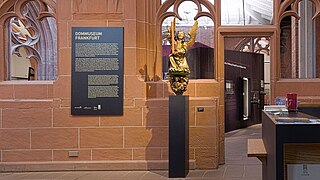
The Frankfurt Cathedral Museum shows ecclesiastical treasure art, a rich collection of medieval and baroque chasubles and important exhibits on the Frankfurt Imperial Cathedral, from early medieval excavation finds to evidence of its historicist redesign in the 19th century. The Cathedral Museum in the historic cloister of the Imperial Cathedral of St. Bartholomew in Frankfurt am Main has been in existence since 1987. The regular exhibition contains some highlights of sacred art. In addition, the museum presents contemporary art or cultural-historical topics in changing exhibitions. Since 2007, a second exhibition space has been the so-called Sacristeum in the neighbouring Haus am Dom.
Sight 18: Kaiserpfalz franconofurd
The former Archaeological Garden in Frankfurt am Main was built in 1972/73 during the construction of the Dom/Römer underground station. As part of the Dom-Römer project, the Archaeological Garden was built over with the Stadthaus am Markt from 2013 to 2016 in order to protect the excavations from the weather and to keep them permanently accessible. In August 2018, the exhibition was reopened in the basement of the Stadthaus as a branch of the Archaeological Museum Frankfurt under the new name Kaiserpfalz Franconofurd. It presents in a new architectural and museum design the remains of the Roman settlement on the Frankfurt Cathedral Hill, of a Merovingian royal court, of the Carolingian-Ottonian royal palace of Frankfurt, as well as late medieval cellar.
Sight 19: Stoltze-Brunnen
The Stoltze Fountain is a fountain built in the 1890s on the Hühnermarkt in the old town of Frankfurt am Main; it is a listed building. During the reconstruction of the Römer, from 1981 to 2016, it stood on Friedrich-Stoltze-Platz behind St. Catherine's Church▼.
Sight 20: Frankfurter Kunstverein
The Frankfurter Kunstverein e. V. in Frankfurt am Main is a non-profit organisation dedicated to the promotion of contemporary art and culture. It is one of the oldest German art associations.
Sight 21: Steinernes Haus
The Steinernes Haus, also known as Haus Bornfleck in older literature, is a historic building in the old town of Frankfurt am Main. It faces the market, which connects the cathedral with the Römerberg. Above all, its medieval architecture and its very long, well-documented history make it stand out from other buildings in the old town.
Sight 22: Haus Frauenstein
Haus Frauenstein is a historic building in Frankfurt am Main, Germany. It is part of the Römerzeile, Frankfurt's town hall complex. As the fourth building in the row, it borders on the left (south) of the Löwenstein House and on the right (north) of the Salzhaus. The house address is "Römerberg 25".
Sight 23: Salzhaus
The Salzhaus is a historic building in the German city Frankfurt am Main. It forms the northeastern part of the Frankfurt City Hall complex (Römer), on the Römerberg square in the centre of the Altstadt.
Sight 24: Gerechtigkeitsbrunnen
The Fountain of Justice is a fountain on the Römerberg in Frankfurt am Main and one of the city's landmarks. It goes back to a predecessor building from 1543 on the same site and was built in its present form in 1611. During the time of the Holy Roman Empire, it played a special, albeit short-lived, role during the coronation ceremony as a wine fountain for the emperor and then also for the people. The fountain that can be seen today is a largely detailed copy from 1887, which was financed by the Frankfurt wine merchant Gustav D. Manskopf. It is a listed building.
Wikipedia: Gerechtigkeitsbrunnen (Frankfurt am Main) (DE), Heritage Website
Sight 25: Haus zum Römer
The Haus zum Römer, also known as Römer, is the eponymous middle house of the three-gable façade of the Frankfurt City Hall complex. It was first mentioned in 1322 and was bought by the city in 1405. Probably built in the early 14th century, it is architecturally still a representative of classical Gothic patrician architecture, despite massive exterior and interior alterations in the more than 700 years after its construction.
Sight 26: Haus zum Goldenen Schwan
The House of the Golden Swan, also known as the Golden Swan, is a building in the Frankfurt City Hall complex. It borders to the northwest of the eponymous Haus zum Römer and has always been structurally and historically connected to it. First mentioned in 1322, the building was bought by the city in 1405. Architecturally, despite the structural changes of several centuries, it is still a typical representative of Gothic patrician architecture.
Sight 27: Haus Wertheym
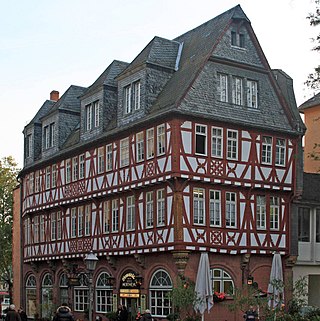
The Wertheim House, also known as Wertheym, is a half-timbered house built around 1600 at the Fahrtor in Frankfurt am Main. It is the only house with exposed half-timbering in Frankfurt's old town that has survived the air raids on Frankfurt am Main almost unscathed. The house is a listed building. Until the destruction of the old town, it received little attention. Today, with its massive ground floor with sandstone arcades, the two cantilevered half-timbered upper floors and the slate attic, it is considered typical of the Frankfurt architectural style. Since the 1970s, its appearance and its status as the last of what used to be more than 1200 half-timbered houses in the old town have contributed to promoting the desire for comprehensive reconstructions of representative old town houses among Frankfurt's citizens.
Wikipedia: Haus Wertheim (Frankfurt am Main) (DE), Url, Heritage Website
Sight 28: Historical Museum Frankfurt
The Historical Museum in Frankfurt am Main, Germany, was founded in 1878, and includes cultural and historical objects relating to the history of Frankfurt and Germany. It moved into the Saalhof in 1955, and a new extension was opened in 1972.
Sight 29: St. Leonhard
St. Leonhard is a parish of the Roman Catholic Church in Frankfurt, Hesse, Germany. Its historic church dates to 1219, when it was erected in the centre of the town close to the river Main, as a Romanesque-style basilica. From 1425, it was remodeled to a hall church in late Gothic style. St. Leonhard was the only one of nine churches in the Old Town that survived World War II almost undamaged. Today, the parish is part of the Domgemeinde and serves as the parish church of English-speaking Catholics. It is a monument of Frankfurt's history as well as church history and medieval crafts.
Sight 30: St. Paul's Church
The Paulskirche in Frankfurt am Main is a former church building used as an exhibition, memorial and meeting place. It was built between 1789 and 1833 on the site of the medieval Barfüßerkirche, which was demolished in 1786, and served as Frankfurt's main Evangelical Lutheran church until 1944, which is now the Katharinenkirche. From 1848 to 1849, the delegates of the Frankfurt National Assembly, the first parliament for the whole of Germany, met in the classicist rotunda by the architect Johann Friedrich Christian Hess. St. Paul's Church, along with Hambach Castle, is thus considered a symbol of the democratic movement in Germany and a national symbol. From this most important epoch for St. Paul's Church and the history of German democracy, however, there is almost nothing left of the interior decoration.
Wikipedia: Frankfurter Paulskirche (DE), Website, Heritage Website
Sight 31: Goethe House
The Goethe House is a writer's house museum located in the Innenstadt district of Frankfurt, Germany. It is the birthplace and childhood home of German poet and playwright Johann Wolfgang von Goethe. It is also the place where Goethe wrote his famous works Götz von Berlichingen, The Sorrows of Young Werther, and the first drafts of Urfaust. The house has mostly been operated as a museum since its 1863 purchase by the Freies Deutsches Hochstift, displaying period furniture and paintings from Goethe's time in the house.
Sight 32: Die Schmiere

The cabaret Die Schmiere was founded in 1950 by Rudolf Rolfs and is one of the oldest private theatres in Frankfurt am Main. The theatre describes itself as "The worst theatre in the world"; the name "Schmiere" is also a pejorative term for bad theatre, a so-called smear theatre.
Sight 33: Euro-Skulptur
The Euro-Skulptur by Ottmar Hörl set up at Willy-Brandt-Platz in Frankfurt am Main, Germany, is one of two copies of the work that have been put on public display. It is a 14-metre (46 ft) tall electronic sign that shows a Euro sign and twelve stars around, weighing 50 tonnes.
Sight 34: Gallusanlage
The Frankfurt ramparts form a ring-shaped green area around the city centre of Frankfurt am Main. They were built at the beginning of the 19th century on the site of Frankfurt's city fortifications, which were razed between 1804 and 1812. The Frankfurt Anlagenring runs around the ramparts.
Sight 35: Märchenbrunnen
The Märchenbrunnen or Schauspielhausbrunnen in Frankfurt am Main is located on the Untermainanlage next to the Städtische Bühnen Frankfurt. It is an Art Nouveau fountain that was completed in 1910.
Wikipedia: Frankfurter Märchenbrunnen (DE), Website, Heritage Website
Sight 36: Oper Frankfurt
The Oper Frankfurt is a German opera company based in Frankfurt.
Sight 37: Untermainanlage
The Frankfurt ramparts form a ring-shaped green area around the city centre of Frankfurt am Main. They were built at the beginning of the 19th century on the site of Frankfurt's city fortifications, which were razed between 1804 and 1812. The Frankfurt Anlagenring runs around the ramparts.
Sight 38: Jewish Museum
The Jewish Museum Frankfurt am Main is the oldest independent Jewish Museum in Germany. It was opened by Federal Chancellor Helmut Kohl on 9 November 1988, the 50th anniversary of Kristallnacht.
Sight 39: Museum Angewandte Kunst
The Museum Angewandte Kunst (MAK) is located in Frankfurt am Main, Germany, and is part of Frankfurt's Museumsufer. The alternating exhibitions recount tales of cultural values and changing living conditions. Beyond that, they continually refer to the question of what applied art is today and can be and demonstrate the field of tension between function and aesthetic value.
Sight 40: Villa Metzler
The Villa Metzler is a classicist country house built in 1803 and later rebuilt on the banks of the Main in Frankfurt am Main, Sachsenhausen.
Sight 41: Deutsches Filmmuseum
The German Film Museum on the Museumsufer in Frankfurt am Main is a film museum in Germany. It is housed in a listed historic villa.
Sight 42: Deutsches Architekturmuseum
The German Architecture Museum (DAM) is located on the Museumsufer in Frankfurt, Germany. Housed in an 18th-century building, the interior has been re-designed by Oswald Mathias Ungers in 1984 as a set of "elemental Platonic buildings within elemental Platonic buildings". It houses a permanent exhibition entitled "From Ancient Huts to Skyscrapers" which displays the history of architectural development in Germany.
Sight 43: Städtische Galerie Liebieghaus
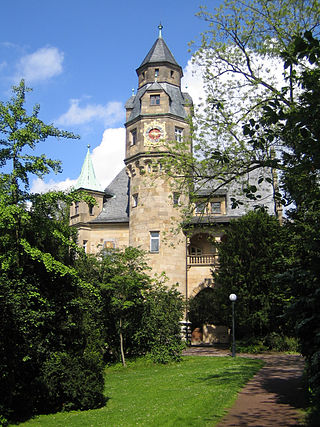
The Liebieghaus is a late 19th-century villa in Frankfurt, Germany. It contains a sculpture museum, the Liebieghaus Skulpturensammlung, which is part of the Museumsufer on the Sachsenhausen bank of the River Main. The collection comprises some 3,000 sculptures, spanning over 5,000 years of culture.
Sight 44: Museum Giersch der Goethe-Universität
The Museum Giersch is an art gallery on the Main River in Frankfurt am Main, Germany, in the Museumsufer area.
Sight 45: Der Hafenarbeiter
Débardeur du port d'Anvers, also known as Der Hafenarbeiter is a bronze sculpture created by Belgian artist Constantin Meunier in 1890.
Sight 46: Gewerkschaftshaus Frankfurt
The Trade Union House in Frankfurt am Main is a listed office building that was inaugurated in 1931. Today, the high-rise building in the Gutleutviertel is the headquarters of the German Trade Union Confederation, the district of Hesse-Thuringia and the Frankfurt-Rhine-Main region and the trade union ver.di in the Frankfurt am Main district and region.
Sight 47: Weißfrauen Diakoniekirche Frankfurt
The Weißfrauenkirche was a Protestant church in the old town of Frankfurt am Main. It burned down after a bombing raid on March 22, 1944. Its remains were removed during reconstruction in 1952 in favor of the street breakthrough of Berliner Straße. In 1955/56, a new Weißfrauenkirche was built west of the city centre in the station district, which was rededicated to a diaconal church in 2002/04.
Share
How likely are you to recommend us?
Disclaimer Please be aware of your surroundings and do not enter private property. We are not liable for any damages that occur during the tours.
GPX-Download For navigation apps and GPS devices you can download the tour as a GPX file.
